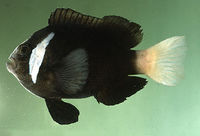Difference between revisions of "Amphiprion mccullochi"
From The Aquarium Wiki
m |
|||
| Line 35: | Line 35: | ||
|max_water_hardness=12 | |max_water_hardness=12 | ||
}} | }} | ||
| − | + | ||
| − | + | == Origin == | |
| − | + | :Lord Howe island, one of the Great Barrier Reef's southernmost islands. | |
| − | + | ||
| − | + | ||
| − | + | == Sexing == | |
| − | + | :Males are smaller than females. | |
| − | + | ||
| − | + | ||
| − | + | == Tank compatibility == | |
| + | :Peaceful or tolerant of heterospecifics. Can act very aggressively and territorial to conspecifics. In fact, it appears that their aggressive nature makes it challenging to form breeding pairs. | ||
| + | |||
| + | |||
| + | == Diet == | ||
| + | :Carnivore | ||
| + | |||
| + | |||
| + | == Feeding regime == | ||
| + | :Feed once or twice a day. | ||
| + | |||
| + | |||
| + | == Environment specifics == | ||
| + | :Does best in a rocky reef setting. Associated with the anemone ''[[Entacmaea quadricolor]]''. | ||
| + | |||
| + | |||
| + | == Behaviour == | ||
| + | : Can be very aggressive and territorial toward conspecifics. Dominant fish would continuously harass the subdominant fishes through pinning and tearing apart fins. When forming aggregations or breeding pairs, the quarist must carefully observe the fish. If aggressive actions increase too high, then the fish ought to be separated with mesh dividers, clear perforated cups, and other tools. | ||
| + | |||
| + | |||
| + | == Identification == | ||
| + | :An oval fish with a white caudal fin, black body and a white vertical band over the gill plate. | ||
| + | |||
| + | |||
{{Categories | {{Categories | ||
|Category=Fish, Fish (Saltwater), Clownfish, Clownfish | |Category=Fish, Fish (Saltwater), Clownfish, Clownfish | ||
Latest revision as of 03:38, 13 December 2017
McCulloch's Clownfish
Amphiprion mccullochi
114 Litres (30 US G.)
7.6-12.7cm (3-5 ")
8.1 - 8.4
20-25.6°C (68 -78 °F)
8-12 °d
1:1 M:F
5-8 years
Family
Pomacentridae
This animal is available captive bred
| You can contribute to the Aquarium Wiki by expanding this article. Dont be shy!. |
Contents
Additional names
- McCulloch's Clownfish, Whitesnout Anemonefish
Origin[edit]
- Lord Howe island, one of the Great Barrier Reef's southernmost islands.
Sexing[edit]
- Males are smaller than females.
Tank compatibility[edit]
- Peaceful or tolerant of heterospecifics. Can act very aggressively and territorial to conspecifics. In fact, it appears that their aggressive nature makes it challenging to form breeding pairs.
Diet[edit]
- Carnivore
Feeding regime[edit]
- Feed once or twice a day.
Environment specifics[edit]
- Does best in a rocky reef setting. Associated with the anemone Entacmaea quadricolor.
Behaviour[edit]
- Can be very aggressive and territorial toward conspecifics. Dominant fish would continuously harass the subdominant fishes through pinning and tearing apart fins. When forming aggregations or breeding pairs, the quarist must carefully observe the fish. If aggressive actions increase too high, then the fish ought to be separated with mesh dividers, clear perforated cups, and other tools.
Identification[edit]
- An oval fish with a white caudal fin, black body and a white vertical band over the gill plate.
Pictures[edit]
External links[edit]
- Fishbase (Mirrors:
 )
)
